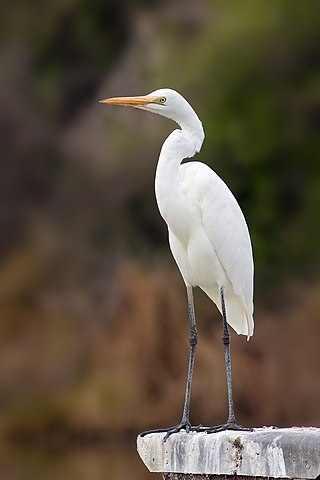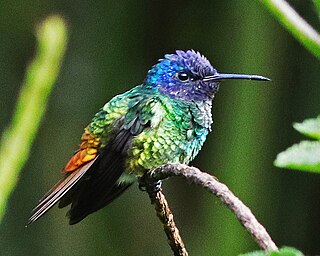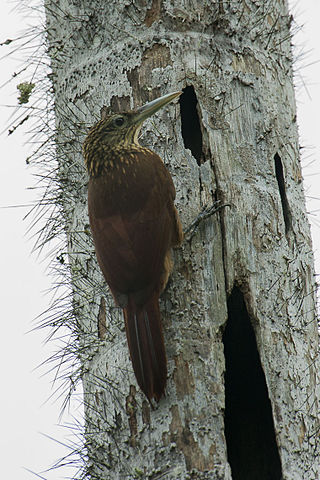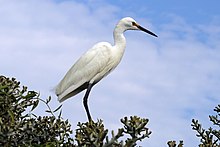
Egrets are herons, generally long-legged wading birds, that have white or buff plumage, developing fine plumes during the breeding season. Egrets are not a biologically distinct group from herons and have the same build.

The great egret (Ardea alba), also known as the common egret, large egret, or great white egret or great white heron, is a large, widely distributed egret. The four subspecies are found in Asia, Africa, the Americas, and southern Europe. Recently it is also spreading to more northern areas of Europe. Distributed across most of the tropical and warmer temperate regions of the world, it builds tree nests in colonies close to water.

The little egret is a species of small heron in the family Ardeidae. It is a white bird with a slender black beak, long black legs and, in the western race, yellow feet. As an aquatic bird, it feeds in shallow water and on land, consuming a variety of small creatures. It breeds colonially, often with other species of water birds, making a platform nest of sticks in a tree, bush or reed bed. A clutch of three to five bluish-green eggs is laid and incubated by both parents for about three weeks. The young fledge at about six weeks of age.

The western reef heron, also called the western reef egret, is a medium-sized heron found in southern Europe, Africa and parts of Asia. It has a mainly coastal distribution and occurs in several plumage forms: a slaty-grey plumage in which it can only be confused with the rather uncommon dark morph of the Little egret ; a white form which can look very similar to the little egret although the bill tends to be paler and larger and the black form with white throat E. g. gularis of West Africa. There are also differences in size, structure and foraging behaviour. There have been suggestions that the species hybridizes with the Little Egret, and based on this, some authors treat schistacea and gularis as subspecies of Egretta garzetta. Works that consider the Western Reef Heron as a valid species include the nominate gularis and schistacea as subspecies.

The intermediate egret, median egret, smaller egret or medium egret, is a medium-sized heron. Some taxonomists put the species in the genus Egretta or Mesophoyx. It is a resident breeder in southern and eastern Asia.

The Pacific reef heron, also known as the eastern reef heron or eastern reef egret, is a species of heron found throughout southern Asia and Oceania. It occurs in two colour morphs with either slaty grey or pure white plumage. The sexes are similar in appearance.

The puna snipe is a bird in tribe Scolopancinai and subfamily Scolopacinae of family Scolopacidae, the sandpipers and relatives. It is found in Argentina, Bolivia, Chile, and Peru.

The streaky-headed seedeater or streaky-headed canary is a small passerine bird in the finch family. It is an unobtrusive but widespread species in suitable habitats of southern Africa. Its presence in an area is revealed foremost by its callnotes.

The red-billed emerald is a species of hummingbird in the "emeralds", tribe Trochilini of subfamily Trochilinae. It is found in Colombia and Venezuela.

The golden-tailed sapphire is a species of hummingbird in the family Trochilidae. It is found in Bolivia, Brazil, Colombia, Ecuador, Peru, and Venezuela.

The red-throated piping guan is a species of bird in the chachalaca, guan, and curassow family Cracidae. It is found in Bolivia and Brazil.

The white-browed spinetail is a species of bird in the Furnariinae subfamily of the ovenbird family Furnariidae. It is found in Colombia, Ecuador, Peru, and Venezuela.

Lafresnaye's woodcreeper is a resident passerine bird found in tropical South America in the western and southern Amazon and adjacent sections of the Cerrado. It is often considered a subspecies of the buff-throated woodcreeper, but this combined "species" would be polyphyletic. It includes the dusky-billed woodcreeper, which sometimes is considered a separate species.

The flame-throated bulbul is a member of the bulbul family of passerine birds and the state bird of Goa. It is found only in the forests of the Western Ghats in southern India. Formerly included as a subspecies of Pycnonotus flaviventris it has since been elevated to the status of a full species. They are olive-backed with yellow undersides, a triangular orange-red throat and a white iris that stands out against the contrasting black head. They are usually seen foraging in groups in the forest canopy for berries and small insects. They have a call often with two or three tinkling notes that can sound similar to those produced by the red-whiskered bulbul. The species has been referred to in the past by names such as ruby-throated bulbul and black-headed bulbul, but these are ambiguous and could apply to other species such as Rubigula flaviventris and R. dispar.

The Australasian figbird, also known as the green figbird, is a conspicuous, medium-sized passerine bird native to a wide range of wooded habitats in northern and eastern Australia, southern New Guinea, and the Kai Islands. It is common in large parts of its range, and occurs in numerous protected areas. Consequently, it is rated as least concern by BirdLife International and the IUCN.

The silver-throated bushtit or silver-throated tit is a species of passerine bird in the family Aegithalidae, widespread throughout the temperate forests of Central, East and parts of North and Western China. The bird's native habitats are mainly along the middle/lower Yangtze and Yellow River basins, although there is also a small southwestern habitat extension in Yunnan along the Lancang valley within the Hengduan Mountains. It has two recognized subspecies.
The West African seedeater is a small passerine bird in the finch family. It is found in Guinea, Sierra Leone, southern Mali and northern Ivory Coast across to southern Niger and northern Cameroon.

The Rio Madeira stipplethroat is a species of bird in subfamily Thamnophilinae of family Thamnophilidae, the "typical antbirds". It is found in Bolivia, Brazil, and Peru. In the past it has also been called eastern stipple-throated antwren, Madeira stipple-throated antwren, Rio Madeira antwren, and Madeira antwren.



















